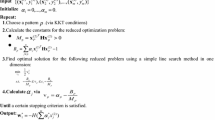Abstract
Twin support vector machine (TWSVM), which solves classification problems through constructing two nonparallel planes by solving two related SVM-type problems, has become a hot spot in the field of machine learning. In addition to keeping the advantages of SVM, the classification performance of TWSVM is also significantly better than that of SVM. However, there are at least two parameters in TWSVM which need to specify. These parameters make great difference to the classification result of TWSVM and to find the optimal parameters is an important but difficult work. In order to overcome this deficiency, in this paper, we propose the twin support vector machines based on Fruit Fly Optimization Algorithm (FOA-TWSVM). This algorithm uses FOA-TWSVM, which has high optimization ability and small computation complexity, to select the parameters for TWSVM. The experimental results show that this algorithm is able to find the suitable parameters, and has higher classification accuracy compared with some other algorithms.







Similar content being viewed by others
References
Cristianini N, Taylor JS (2004) An Introduction to support vector machines and other kernel-based learning methods. Translated by Li Guozheng, Wang Meng, Zeng Huajun. Publishing House of Electronics Industry, Beijing
Shifei D, Bingjuan Q, HongYan T (2011) An overview on theory and algorithm of support vector machines. J Univ Electron Sci Technol China 40(1):2–10
Vapnik VN (2000) The nature of statistical learning theory. Translated by Zhang Xuegong. Tsinghua University Press, Beijing
Vapnik VN (2004) Statistical learning theory. Translated by Xu Jianhua, Zhang Xuegong. Publishing House of Electronics Industry, Beijing
Hui L, Shifei D (2013) Research of individual neural network generation and ensemble algorithm based on quotient space granularity clustering. Appl Math Inf Sci 7(2):701–708
Hui L, Shifei D (2013) Research and development of granular neural networks. Appl Math Inf Sci 7(3):1251–1261
Wang X, He Q, Chen D, Yeung D (2005) A genetic algorithm for solving the inverse problem of support vector machines. Neurocomputing 68:225–238
Wang X, Lu S, Zhai J (2008) Fast fuzzy multi-category SVM based on support vector domain description. Int J Pattern Recognit Artif Intell 22(1):109–120
Fung G, Mangasarian OL (2001) Proximal support vector machine classifiers. In: Proceedings 7th ACMSIFKDD international conference on knowledge discovery and data mining. pp 77–86
Mangasarian OL, Wild EW (2006) Multisurface proximal support vector machine classification via generalized eigenvalues. IEEE Trans Pattern Anal Mach Intell 28(1):69–74
Jayadeva, Khemchandni R, Chandra S (2007) Twin support vector machines for pattern classification. IEEE Trans Pattern Anal Mach Intell 29(5):905–910
Ding S, Junzhao Y, Bingjuan Q (2014) An overview on twin support vector machines. Artif Intell Rev 42(2):245–252
Shao YH, Wang Z, Chen WJ et al (2013) A regularization for the projection twin support vector machine. Knowl-Based Syst 37:203–210
Yu J, Ding S, Jin F, Huang H, Han Y (2012) Twin support vector machines based on rough sets. Int J Digit Content Technol Appl 6(20):493–500
Chen J, Ji G (2010) Weighted least squares twin support vector machines for pattern classification. In: 2010 The 2nd international conference on computer and automation engineering, Singapore: [s.n.], vol 2. pp 242–246
Ye Q, Zhao C, Gao S (2012) Weighted twin support vector machines with local information and its application. Neural Netw 35:31–39
Ding S, Wu F, Shi Z (2014) Wavelet twin support vector machine [J]. Neural Comput Appl 25:1241–1247
Chen W, Shao Y, Deng N (2014) Least squares twin support vector machine for semi-supervised classification. Neuro Comput 145:465–476
Tian YJ, Ju XC, Qi ZQ, Shi Y (2014) Improved twin support vector machine. Sci China Math 57(2):417–432
Wang Y, Zhao X, Tian Y (2013) Local and global regularized twin SVM. Proced Comput Sci 18:1710–1719
Qi Z, Tian Y, Shi Y (2013) Robust twin support vector machine for pattern classification. Pattern Recogn 46(1):305–316
Xie X, Sun S (2015) Multitask centroid twin support vector machines. Neurocomputing 149:1085–1091
Tanveer M (2015) Robust and sparse linear programming twin support vector machines. Cognit Comput 7(1):137–149
Ganesh RN, Dinesh KK, Jayadeva (2010) Twin SVM for gesture classification using the surface electromyogram. IEEE Trans Inf Technol Biomed 14(2):301–308
Arjunan SP, Kumar DK, Naik GR (2010) A machine learning based method for classification of fractal features of forearm sEMG using twin support vector machines. In: Engineering in medicine and biology society (EMBC), 2010 annual international conference of the IEEE. pp 4821–4824
Cong H, Yang C, Pu X (2008) Efficient speaker recognition based on multi-class twin support vector machines and GMMs. In: 2008 IEEE conference on robotics, automation and mechatronics. pp 348–352
Wang Z, Shao YH, Wu TR (2013) A GA-based model selection for smooth twin parametric-margin support vector machine. Pattern Recogn 46(8):2267–2277
Ding S, Yu J, Huang H, Zhao H (2013) Twin support vector machine based particle swarm optimization. J Comput 8(9):2296–2303
Ding S, Wu F, Yu J, Huang H, Zhao H (2013) Twin support vector machines based on quantum particle swarm optimization. J Softw 8(7):1743–1750
Pan WT (2012) A new fruit fly optimization algorithm: taking the financial distress model as an example. Knowl Based Syst 26:69–74
Wang L, Shi Y, Liu S (2015) An improved fruit fly optimization algorithm and its application to joint replenishment problems. Expert Syst Appl 42(9):4310–4323
Acknowledgments
This work is supported by the National Natural Science Foundation of China (No. 61379101).
Author information
Authors and Affiliations
Corresponding author
Rights and permissions
About this article
Cite this article
Ding, S., Zhang, X. & Yu, J. Twin support vector machines based on fruit fly optimization algorithm. Int. J. Mach. Learn. & Cyber. 7, 193–203 (2016). https://doi.org/10.1007/s13042-015-0424-8
Received:
Accepted:
Published:
Issue Date:
DOI: https://doi.org/10.1007/s13042-015-0424-8




